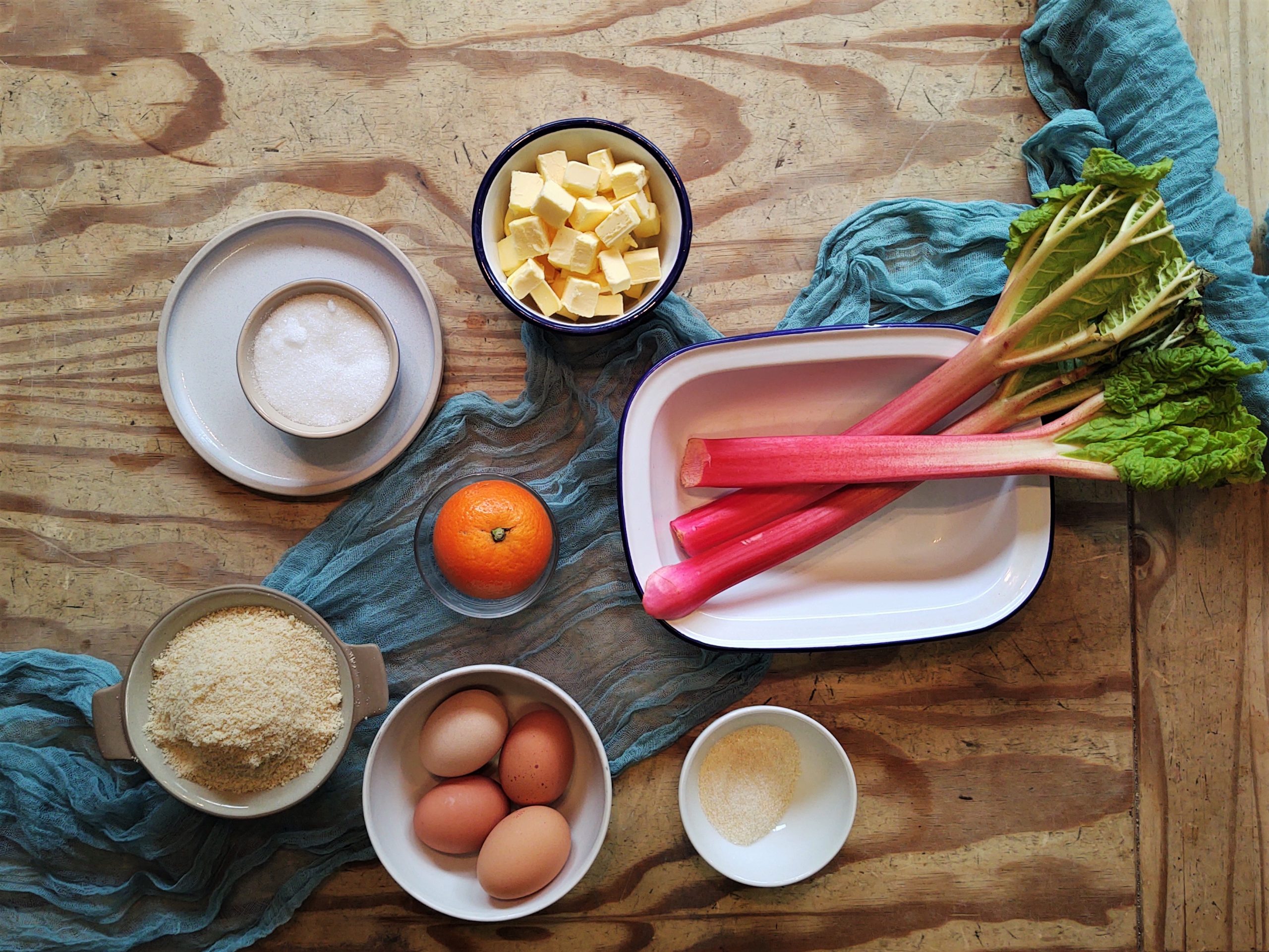It is always an exciting time when the first bright pink stalks of forced rhubarb enter the kitchen! Although they begin to arrive while we are still very much in the middle of winter, the sudden pop of colour brought by forced rhubarb always feels like the first hint that spring is right around the corner.
Unlike outdoor grown rhubarb, which is usually in season during the summer months, forced rhubarb is grown indoors in complete darkness and is picked by candlelight. It is usually available from January to April.

Cake ingredients, including rhubarb, on a table.
Traditionally grown in Yorkshire in the so-called ‘Rhubarb Triangle’, forced rhubarb, as the name suggests, is forced out of its winter hibernation early by moving the roots indoors, where warmth and darkness stimulate the rhubarb roots to rapidly grow upwards, searching for light. This results in the thin, pale pink stalks of rhubarb we see at this time of year.
Forced rhubarb has a milder, sweeter flavour than the mid-summer rhubarb we see growing in our gardens. Thanks to this, forced rhubarb, despite technically being a vegetable, is often found in various desserts. It works particularly well with apples, ginger and custard. However, due to its tartness, rhubarb can work equally as well in savoury dishes, balancing out the richness of fatty meats such as roast pork and sausages, or oily fish like mackerel.
Here are a few of our favourite ways to use forced (or indeed any!) rhubarb.
Spiced rhubarb relish

A bunch of rhubarb. (Photo by Monika Grabkowska on Unsplash.)
Ingredients
- 220g caster sugar
- 200ml cider vinegar
- 1 star anise
- 1 tsp coriander seeds
- 1 tsp fennel seeds
- 1 tsp chilli flakes
- ½ tsp salt
- 1 onion
- 3cm piece of fresh ginger
- 400g rhubarb
Method
- Peel and finely chop the onion and place it in a pan with the sugar and vinegar over a medium heat. Bring the mixture to a boil.
- Peel and finely chop the fresh ginger and add it to the pan along with the spices and salt. Continue to simmer for 10-15 minutes to soften the onions.
- Slice the rhubarb into 1-2cm pieces and add them into the pan. Cook for 5-10 minutes (depending on thickness of the rhubarb pieces), until just tender but still intact.
- Allow to cool a little and store in sterilised jars.
Rhubarb and beetroot ketchup
A seasonal alternative to tomato ketchup which will work equally as well in a bacon sandwich!
Ingredients

Bright pink rhubarb stems. (Photo by Heather Barnes on Unsplash.)
- 2 beetroot
- 1 onion
- 400g rhubarb
- 3cm piece of fresh ginger
- 150g caster sugar
- 75ml red wine vinegar
- 1 star anise
- 3 juniper berries
- ½ tsp black peppercorns
- 1 clove
Method
- Place the beetroot in a pan, cover with water and boil until cooked through (1-2 hours, depending on the size of the beetroot). Allow to cool.
- Peel and finely dice the onion and ginger. Add a splash of oil to a pan and sweat down the onion and ginger with a pinch of salt.
- Roughly chop the rhubarb and add this to the pan. Continue to cook down for a further 5-10 minutes and when the rhubarb has almost broken down, add in the sugar and red wine vinegar.
- Meanwhile, toast the spices in a dry frying pan for a couple of minutes until fragrant and then blitz to a fine powder using a pestle and mortar or a spice grinder. Add into the rhubarb mixture and cook everything for another 5 minutes.
- When the beetroot is cooled, peel and roughly chop the beetroot and add it to a blender along with the rhubarb mixture. Blitz it all together to form a smooth paste. Season with salt and pepper to taste. You may also need to add more sugar or vinegar, depending on the tartness of the rhubarb.
- Spoon into sterilised jars and refrigerate for 1-2 months.
If you liked this guide, consider checking out our guide to quick pickling and fish curing.
If you would like to enable Edinburgh Food Social to continue educating people about local, seasonal food, please consider donating to our organisation. You can also follow us on Instagram, Facebook, LinkedIn and Bluesky to keep up to date with our programs, classes and news.



